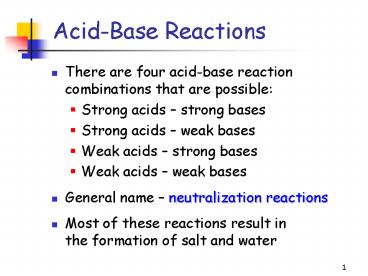There are four acid-base reaction combinations that are possible: - PowerPoint PPT Presentation
Title:
There are four acid-base reaction combinations that are possible:
Description:
1. There are four acid-base reaction combinations that are possible: Strong ... for the reaction of 2 moles of cesium hydroxide with 1 mole of phosphoric acid. ... – PowerPoint PPT presentation
Number of Views:51
Avg rating:3.0/5.0
Title: There are four acid-base reaction combinations that are possible:
1
Acid-Base Reactions
- There are four acid-base reaction combinations
that are possible - Strong acids strong bases
- Strong acids weak bases
- Weak acids strong bases
- Weak acids weak bases
- General name neutralization reactions
- Most of these reactions result in the
formation of salt and water
2
Strong Acid Strong Base
- Type 1 formation of a soluble salt
- HNO3(aq) NaOH(aq) ? NaNO3(aq) H2O(?)
- 2HBr(aq) Ca(OH)2(s) ? CaBr2(aq) 2H2O(?)
- Type 2 formation of an insoluble salt
- H2SO4(aq) Ba(OH)2(aq) ? BaSO4(s) 2H2O(?)
3
Strong Acid Weak Base
- Always form a soluble salt
- HNO3(aq) NH3(g) ? NH4NO3(aq)
- H2SO4(aq) NH3(g) ? (NH4)2SO4(aq)
- Reactions of acids with ammonia lead only to the
formation of soluble salts - Water is not formed in these reactions
4
Weak Acid Strong Base
- Always form a soluble salt
- HNO2(aq) NaOH(aq) ? NaNO2(aq) H2O (?)
- H2SO3(aq) 2RbOH(aq) ? Rb2SO3(aq) 2H2O (?)
5
Weak Acid Weak Base
- Always form a soluble salt
- CH3COOH(l) NH3(g) ? NH4(CH3COO)(aq)
- HF(g) NH3(g) ? NH4F(aq)
- But
- these reactions proceed in the opposite
direction because the products are unstable in
water - The salts formed by weak acid and weak base are
not stable in aqueous solution !!!
6
Acidic Salts
- Polyprotic acids have more than one proton in
their molecules - When reacted with insufficient amount of a base,
such acids do not lose all of their protons - The salts formed in such reactions are called
acidic salts since they can further react with
bases
7
Acidic Salts
- Example
- Sulfuric acid and sodium hydroxide are reacted
- - in a 11 ratio
- H2SO4(aq) NaOH(aq) ? NaHSO4(aq) H2O(?)
- The acidic salt sodium hydrogen sulfate is formed
- - in a 12 ratio
- H2SO4(aq) 2NaOH(aq) ? Na2SO4(aq) 2H2O(?)
- The normal salt sodium sulfate is formed
- Sodium sulfate can also be formed from
the acidic salt sodium hydrogen sulfate - NaHSO4(aq) NaOH(aq) ? Na2SO4(aq) H2O(?)
8
Example 1
- Write total and net ionic equations for the
reaction of 2 moles of cesium hydroxide with 1
mole of phosphoric acid. Name the salt that is
formed.
9
Basic Salts
- Basic salts are formed by the reaction of
polyhydroxy bases with less than the
stoichiometric amount of acid - Example
- Ba(OH)2(aq) HCl(aq) ? Ba(OH)Cl(aq) H2O(?)
- The basic salt barium hydroxochloride is formed
- Ba(OH)2(aq) 2HCl(aq) ? BaCl2(aq) 2H2O(?)
- The normal salt barium chloride is formed
- Barium chloride can also be formed from the
basic salt barium hydroxochloride - Ba(OH)Cl(aq) HCl(aq) ? BaCl2(aq) H2O(?)
10
Example 2
- Write total and net ionic equations for the
reaction of 1 mole of strontium hydroxide with 1
mole of hydrobromic acid. Name the salt that is
formed.
11
The Lewis Theory
- This is the most general of the present day
acid-base theories - It emphasizes what happens to the electrons as
opposed to what happens to the protons - Acids are electron pair acceptors
- Bases are electron pair donors
- An acid-base reaction is a transfer of the
electron pair from base to acid
12
The Lewis Theory Examples
- NH3 H2O ? NH4 OH
- HBr H2O ? H3O Br
13
The Lewis Theory
- The Lewis theory is more general than the
Brønsted-Lowry theory since it is not limited to
the compounds with protons - NaF BF3 ?? Na BF4
- Neutralization in the sense of the Lewis theory
is the formation of a covalent bond through the
donor-acceptor mechanism
14
Example 3
- Describe the reaction between BF3 and NH3 in
terms of the Lewis theory
15
The Lewis Theory
- Lewis bases electron pair donors
- Species with a lone pair of electrons
- Anions
- Lewis acids electron pair acceptors
- Species with an incomplete octet
- Cations
- Molecules with polar double bonds
- Atoms with expandable valence shells
16
The Lewis Theory Examples
- H OH ?
- Na Cl ?
- CO2 H2O ?
- SnCl4 2Cl ?
17
CHAPTER 11
- Reactions in Aqueous Solutions II Calculations
18
Concentration of Solutions
- Percent by mass
- Molarity
19
Example 4
- 12.4 g of Na2SO4 is dissolved in 120 ml of water.
What is the molarity of the soltution with
respect to - - sodium sulfate ?
- - sulfate anions ?
- - sodium cations ?
20
Example 5
- 300 ml of a 0.2 M solution of cesium hydroxide
was neutralized with 200 ml of a 0.3 M solution
of acetic acid. What is the resulting molarity of
the obtained cesium acetate solution?
21
Reading Assignments
- Read Chapter 10 completely
- Read Sections 4-5 4-6 of Chapter 4
- Read Section 6-8 of Chapter 6































